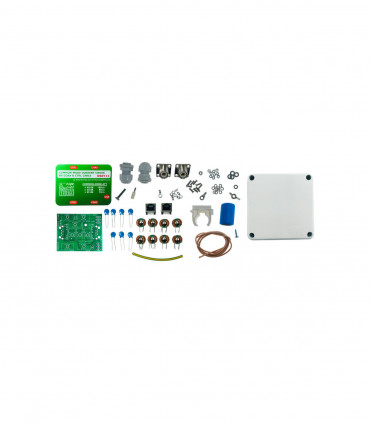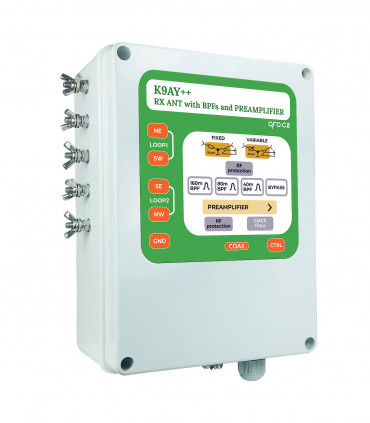K9AY++ RX Antenna
The K9AY is terminated loop RX antenna. It consists of a wire loop of any convenient shape (diamond, delta, etc), hung from a single support and with a ground rod at the bottom. A 9:1 impedance-matching transformer is connected from one end of the loop to the ground and a terminating resistor is connected the other end of the loop to the ground. This antenna is directional. Favoring signals are arriving from the feed point end. You can also change the antenna far field by changing RLOAD (RTERM) of the loop. This set including the RF feeder box and the controller. Antenna has got Band Pass Filters and Preamplifier in the feed point of the loops. It is advantage of filtering and amplification small signals directly from antenna.
This is plastic box with the aluminium holder. Inside it, there is transformer with insulated windings, variable and FIXed Rload for the antenna loop, input and output protections. And in the middle of that there are 160/80/40m BPFs or bypass and 15dB preamp with variable ATT. You can set the Gain of the preamp very easy as you need. From 0 to 18 dB.
All you need is connect loops' wires, GND, coax cable and control cable (CAT-5 UTP or better FTP)
Jump to
Antenna Ground
Locating your K9AY Loops
K9AY Loop design
Loop connection
What is inside
Variable and Fixed Rload resistor
Tune and test points
Connector description
Options: Recommendations to buy
Videos
FAQ
Product details
Antenna Ground
This K9AY antenna doesn't work without ground:
- - it loses the f/b directivity
- - this means that it needs good ground
A 4-foot ground rod (such as 3/4" diameter copper pipe) is often sufficient. It the earth is very dry, a longer ground rod is advised, to reach permanently moist earth - or you may install four or more 15 to 20 foot long radial wires for better coupling to ground. The grounded design of the K9AY Loop has several advantages over ground-independent versions of the terminated loop (Pennant and Flag), including simpler switching, no feedline isolation problems, and greater signal capture for the same size loops (source: K9AY AY Technologies).
Connecting the GND
- there is common GND on the screw under loops connections and also on the aluminium holder
- you can mount box directly on the GND rod
- for Coax and control cable are recommended Common-mode current chokes (CMCC)
Locating your K9AY Loops
Since you have chosen a small receiving antenna, it is likely that your transmitting antenna will be nearby. Transmitting antennas, power lines, towers and other nearby large conducting objects can re-radiate signals that are coupled to the receiving antenna. To avoid this problem, locate the K9AY Loop as far from the transmitting antenna as possible. Because the loop is small, it is often possible to place it among trees or shrubs in a front or side yard, while the transmitting antenna is in back. Another way to minimize the interaction is to locate the loop toward the most important direction you want to hear. For example, if you are most interested in hearing Europe from the US, locate the loop Northeast of the transmitting antenna. When pointed toward Europe, the null will be in the direction of the transmitting antenna, reducing the pickup of re-radiated signals. Some European users of the K9AY Loop have chosen single loops, placing one of them Northwest of the transmitting antenna to hear US stations, with another East of Northeast to hear Asia and the Far East (source: K9AY AY Technologies).
Controller is universal for 0 or 45 deg orientation - image
K9AY Loop design
- Please read our short technical article about K9AY loop design and simulations. You can select some size or download MMANA files and play with your own one :) You can try different shapes, height and load resistance. You can better understand how it works and how you can build it better.
Loop connection
- - this is very important thing which has effect on final antenna parameters
- - if you end lower part of loops as close to ground as possible, you can obtain better F/B
- - install RF feeder box higher - protect from snow, water etc. and connect loops with twisted wires from loops to screws
effect of low part of loops
Place loops as low as possible. GREEN = on ground, RED = 0.5m, BLUE = 0.8m
What is inside
There is PCB in the feeder box which is assembled with Direction switch relays, Rload system (fixed and variable), Impedance transformer, Band Pass Filters, Preamplifier with Variable Attenuator, Protections and Common-mode filters.
Variable and Fixed Rload resistor
Antenna Loop needs LOAD resistance at one side of the loop. It is connected between end of the loop and ground. Size of the Load Resistance (Rload) - depends on size of the loop and frequency. You can set optimal value what effect on SWR and F/B. It is not very critical and in the most cases you can switch to FIXed value.
Connector description
- - there is standard RJ45 (ETHERNET) connector with shielding - THIS IS NOT LAN PORT!
- - you can use cheap CAT-5 or CAT-6 cable up to 100m - FTP version - shielded
- Please read this instruction, use ONLY Copper wires
Tune and test points
Antenna Loop needs LOAD resistance at one side of the loop. It is connected between end of the loop and ground. Size of the Load Resistance (Rload) - depends on size of the loop and frequency. You can set optimal value what effect on SWR and F/B. It is not very critical and in the most cases you can switch to FIXed value.
1. Variable ATT
- preamplifier with 2SC5551A has got 18 dB of total gain
- in many cases it is more than you need
- there is VARIABLE ATT trimmer (R_ATT1), it allows you to set gain from NO signal to maximal gain of the preamplifier
- ATT trimmer has got 30 turns with no end stops
- total gain including BPF is PRESET to 10 dB from our final testing
- for higher gain turn clockwise
2. Preamp BIAS
- this is trimmer (RBIAS1) which sets transistor bias current
- higher current means higher IP3
- recommended is 40 to 50 mA - higher currents need better cooling
- with bias current around 15 mA, the noise figure of the preamplifier is around 1
- for setting this bias current open jumper JP1 and measure it there
3. Rload tune
- this trimmer (R6 SET Rload) can be use for final loop resistance tune
- there is a trimmer for maximal resistance in the controller - front panel trimmer MAX
- set Rload potentiometer on controller to middle position (5)
- jumper JP2 must be set to Variable (see next notes)
- set DIRECTION switch to NE
- disconnect antenna loops
- left coax connected to antenna and controller
- use Ohm meter and measure between GND and SW screw
- tune Rload trimmer to resistance you like (400 to 500 Ohm)
⚠ IMPORTANT NOTE: Final Rload resistance may vary with the direction switching. This is caused by thin GND wire between controller and RF feeder box. If the changing is lower than 10 % then all is OK, if more, then more GND wires are recommended. Using CAT-5 FTP (shielded) cable can be big advantage in this problem.
⚠ IMPORTANT NOTE: For final tuning and measuring, please connect control cable as well also the coax one!
4. Direction LED
- LED indication for checking
- LEDs must follow matrix table on the PCB while switching by the direction knob on controller
5. Rload VAR/FIX
- jumper JP2 allow to select FIXed or VARiable resistance for the loops
- FIXed one is around 470 Ohm/4 W, knob on the controller does not work
- while it is set to VAR, you can tune resistance from typ. 200 to 1000 Ohms
- there is a trimmer for maximal resistance in the controller - front panel trimmer MAX
- load resistor has got high voltage and current protections
6. Preamp current TP
- you can open this jumper (JP1) and check/set transistor current
- set switch on controller to preamp ON
- Bias current should be in range 10 to 50 mA - recommended is 40 mA
Options: Recommendation to buy CMCC
Common-mode choke coils work as a simple wire against differential mode current (signal), while they work as an inductor against common-mode current (noise). This box is designed as a common-mode filter for RF cable and also for analog AC/DC controller wires. This version is directly designed for K9AY++ antenna system. Our offer of CMCC.















































